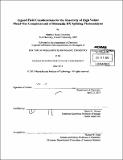| dc.contributor.advisor | Daniel G. Nocera. | en_US |
| dc.contributor.author | Chambers, Matthew Burke | en_US |
| dc.contributor.other | Massachusetts Institute of Technology. Department of Chemistry. | en_US |
| dc.date.accessioned | 2013-11-18T19:07:21Z | |
| dc.date.available | 2013-11-18T19:07:21Z | |
| dc.date.copyright | 2013 | en_US |
| dc.date.issued | 2013 | en_US |
| dc.identifier.uri | http://hdl.handle.net/1721.1/82312 | |
| dc.description | Thesis (Ph. D.)--Massachusetts Institute of Technology, Dept. of Chemistry, 2013. | en_US |
| dc.description | Cataloged from PDF version of thesis. | en_US |
| dc.description | Includes bibliographical references. | en_US |
| dc.description.abstract | Inorganic molecular complexes are used to probe mechanistic steps in two reaction reactions related to energy storage. The first reaction considered is the O-O bond formation step required for water oxidation to oxygen. The second reaction considered is the photocatalytic generation of hydrogen and halogen from hydrohalic acid. Regarding the O-O bond formation process, terminal metal oxo complexes of pseudotetrahedral geometry were synthesized and studies focused on determining the electronic structure of these complexes as well as reactivity patterns. A novel series of low coordinate tris(alkoxide) complexes of divalent and trivalent metals were synthesized and characterized as single metal site models of oxidic metal clusters. Via oxygen atom transfer reactions, d⁰, d¹, and d² early transition metal-oxo complexes were stabilized. Analysis of structural parameters, infrared spectroscopy and DFT calculations establish that the first two d electrons fill degenerate [pi]* orbitals with respect to the M-O bond. An electronic structure was determined wherein there is a low lying degenerate dxz, dyz set of orbitals, a more destabilized degenerate set of dxy, dX2-y2 orbital, with dz2 as the most destabilized d orbital. Upon addition of oxygen atom transfer reagents to tris(alkoxide) divalent iron complexes, rapid C-H bond abstraction is observed to afford an Fe(III)-OH moiety. This rapid and indiscriminate nature in which this reaction proceeds is calculated to arise from the production of a terminal Fe(IV) oxo intermediate complex with a quintet spin state. The exceptionally weak ligand field orthogonal to the ferryl is proposed to stabilize a high spin state and promote the reactivity. Regarding HX splitting, a new dirhodium diphosphazane structure is evaluated for photocatalytic HX splitting behavior. The complex photoreduces protons but degrades quickly. Rational ligand modifications afford an indefinitely stable proton reduction photocatalyst. Upon proton reduction from hydrohalic acid, valence isomers of a tetrachloride product were isolated. The efficiencies of halide elimination from the valence symmetric and mixed valent complexes were determined to be similar. Calculations suggest that halogen elimination proceeds through a bridging halide structure and access to this structure is the determining factor for the efficiency of halogen elimination. | en_US |
| dc.description.statementofresponsibility | by Matthew Burke Chambers. | en_US |
| dc.format.extent | 244 p. | en_US |
| dc.language.iso | eng | en_US |
| dc.publisher | Massachusetts Institute of Technology | en_US |
| dc.rights | M.I.T. theses are protected by
copyright. They may be viewed from this source for any purpose, but
reproduction or distribution in any format is prohibited without written
permission. See provided URL for inquiries about permission. | en_US |
| dc.rights.uri | http://dspace.mit.edu/handle/1721.1/7582 | en_US |
| dc.subject | Chemistry. | en_US |
| dc.title | Ligand field considerations for the reactivity of high valent metal-oxo complexes and of bimetallic HX splitting photocatalysts | en_US |
| dc.type | Thesis | en_US |
| dc.description.degree | Ph.D. | en_US |
| dc.contributor.department | Massachusetts Institute of Technology. Department of Chemistry | |
| dc.identifier.oclc | 861601749 | en_US |
